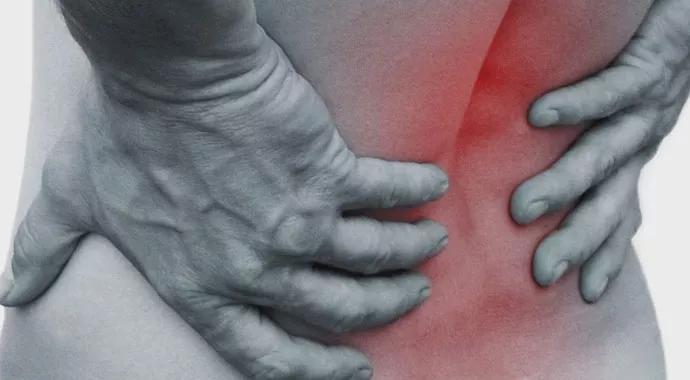Advertisement
Introducing: Cleveland Clinic’s Spine Care Path

Nearly a dozen clinical practice guidelines on managing low back pain have been published in the past decade, yet there’s little evidence they’ve altered physician practice, improved patient outcomes or enhanced the value of care. That needs to change, says Philippe Berenger, MD, a staff physician in Cleveland Clinic’s Department of Pain Management.
Advertisement
Cleveland Clinic is a non-profit academic medical center. Advertising on our site helps support our mission. We do not endorse non-Cleveland Clinic products or services. Policy
“Promising new treatments for low back pain are constantly emerging, but many ultimately prove no more effective than past treatments,” he explains. “It’s critical to confirm that new therapies are supported by evidence and that clinical guidelines are followed to ensure optimal outcomes and cost-effective care.”
Cleveland Clinic is taking on these challenges in two broad ways: with its new Spine Care Path to systematically reduce variation from evidence-based care, and via highly integrated, enterprisewide collaboration for the most challenging cases.
The Cleveland Clinic Spine Care Path is a process-based tool designed for integration in the electronic medical record (EMR) to guide clinical work flow and help providers make evidence-based guidelines operational.
The care path was developed by Cleveland Clinic’s Center for Spine Health with input from Department of Pain Management staff like Dr. Berenger. One goal was to match appropriate treatments and providers to patients at various points along the care continuum for low back pain.
“We know acute back pain is common and often resolves with simple therapy or even no therapy,” Dr. Berenger says. “For patients without red flags, imaging is rarely required.”
These patients may be best served through prompt access to care from physical therapists or nurse practitioners as entry-level providers. When pain persists beyond four to six weeks, the care path defines when referral to spine or pain specialists, spine surgeons or behavioral health providers is indicated.
Another objective was reducing variation from evidence-based practice, which can be costly — and potentially harmful — without benefiting patients. “Providing care along a specific pathway helps avoid overtesting and excessive imaging,” Dr. Berenger notes.
Under the care path, when patients first present with acute back pain, they are evaluated for red flags suggestive of malignancy or other underlying disease. If red flags are ruled out, management is guided through a consistent, evidence-based protocol that follows these principles:
Imaging is not necessary
Advertisement
Central to the process is the Spine Care Path’s integration into the EMR, which assists the clinician by flexibly encouraging adherence to guidelines-based care at every turn. Likewise, patient-reported data are fed into the EMR at each visit as patients complete validated pain and function questionnaires on tablet devices using a Cleveland Clinic-developed intake tool called the Knowledge Program. This allows patient progress to be monitored and correlated with process measures like imaging use and appropriate referrals, which will enable the care path to be continually improved over time.
Identifying the pain generator is important in guiding low back pain management, especially in cases that don’t respond to conservative measures like first-line drugs or physical therapy. Isolating the pain generator is often an initial focus when patients require referral to a spine or pain specialist.
For such patients, Dr. Berenger may use diagnostic blocks (e.g., facet blocks, joint anesthetic injections, discograms or medial nerve branch blocks) to isolate the pain generator and guide interventional management. Once a pain generator is identified, some of these same blocks can be used therapeutically at the implicated disk or nerve, typically along with physical therapy. Patients often respond to such management and can be maintained on it or gradually weaned from it.
Advertisement
Those who do not gain adequate relief may be referred for further evaluation, including for spine surgery or enrollment in a clinical trial for interventions such as disk biacuplasty or minimally invasive neurostimulation.
Dr. Berenger and colleagues also comprehensively evaluate for confounding conditions, such as fibromyalgia or rheumatologic disease, through blood tests, X-rays and consults. “Even when back pain can be attributed to structural problems, confounding conditions or psychosocial issues still need to be addressed for the patient to recover and regain function,” he says.
That’s when Cleveland Clinic’s collaborative approach — formalized under the Spine Care Path — can yield the greatest benefits. “We offer enterprisewide evaluation for challenging cases, drawing on the Center for Spine Health, the Department of Pain Management, our comprehensive Chronic Pain Rehabilitation Program, neurologists, behavioral health providers and others,” Dr. Berenger notes. “Patients can expect a better experience — and much less jumping between unconnected providers — with all these specialists with different skill sets cooperating to deliver an outcome that’s meaningful to them.”
Advertisement
Advertisement

Program enhances cooperation between traditional and non-pharmacologic care

Pain specialists can play a role in identifying surgical candidates

Clinical judgment is foundational to appropriately prescribing

The device is a less invasive alternative for patients who are struggle with chronic pain

The Four Pillar Project provides physicians with evidence-based talking points to quickly identify problem areas and educate patients to optimize important aspects of their health.

When conservative approaches don’t work, it may be time to turn to sacroplasty

Fourth iteration of the guidelines focuses on high-risk patient identification and evidence on newer drugs

It is a lifestyle commitment that can minimize pain and improve lives